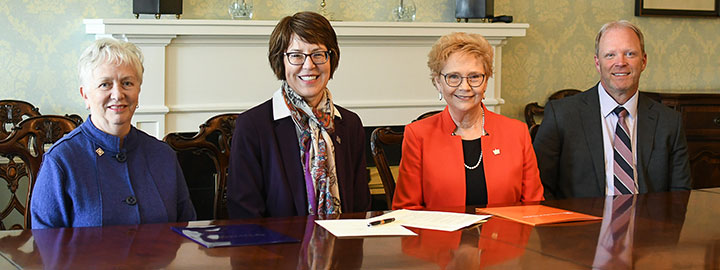Strong roots, Brighter future

Proposed merger makes history
University of Findlay and Bluffton University are joining in a historic partnership.
At campus meetings and a press conference on March 20, UF President Dr. Katherine Fell, and Bluffton President Dr. Jane Wood, announced the signing of a memorandum of understanding with the intention to pursue a merger of Bluffton operations with UF.
The decision was supported by both institutions’ Boards of Trustees. Pending all regulatory approvals, the merger is anticipated to make a positive impact on the higher education landscape in Ohio and beyond.
“Higher education faces significant challenges,” Fell noted. “These times call upon us to be innovative and forward-thinking, and I believe this merger will prove to be both.”
Between 2018 and 2022 there were 95 college mergers across the nation. Throughout the past year, 14 colleges or universities closed, most of them private, four-year institutions.
Both presidents emphasized that this is not a cost-cutting endeavor but an opportunity for a stronger, larger university with two campuses.
“Our early interactions have made clear that we share a commitment to preparing generations of students to find and live out their callings,” Wood explained.
“By combining the best of pre-professional and liberal arts programs, our institutions will become even better at equipping future students to discover and to research what will ultimately bring meaning and purpose to their lives. We are stronger together.”

Bluffton University Board of Trustees Chair Cheryl Hacker, Bluffton University President Jane Wood, University of Findlay President Katherine Fell and University of Findlay Board of Trustees Chair Chris Ostrander are pictured here after signing the Memorandum of Understanding for a proposed merger of the two institutions.
In fall 2023, the Boards of Trustees hired Higher Ed Consolidation Solutions to complete an objective, third-party due diligence report including all financials to assess the benefits and risks of a merger. The assessment found no major barriers and identified many benefits.
Both presidents affirmed students and employees would benefit from access to expanded resources on both campuses, located 20 miles apart in northwest Ohio.
“Together, we can achieve efficiency through shared resources in IT services such as software, vendor contracts in food and insurance, and more,” Wood said. “Additionally, our two campuses would enjoy expanded human resources, counseling and Title IX services.”
Pending NCAA approval, Findlay would continue to participate in NCAA Division II as the Oilers, while Bluffton would continue competing in Division III as the Beavers.
UF intends to remain affiliated with the Churches of God, General Conference, while Bluffton would remain affiliated with Mennonite Church USA.
“Both universities are vital members of our respective communities,” Fell pointed out. “Community leaders and area residents recognize and value the contributions we make to education, economic development, and an improved quality of life. The merger would enrich these contributions.”
Entering the next phase, Fell said 16 transition teams have been formed to envision a “best of” approach for integrating the campuses. Some teams are focusing on areas such as academic affairs; advancement and alumni; athletics; faith and culture; finance and administrative processes; information technology; institutional branding; and student services. More than 90 faculty and staff from both universities are serving on transition teams.
“We see a brighter future ahead – one where the University of Findlay and Bluffton University come together to establish an even stronger premier private institution of higher education in northwest Ohio,” Fell said.
For more information, visit the joint website, www.FindlayBlufftonFuture.com.